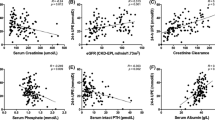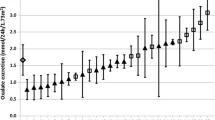Abstract
Preliminary metabolic assessment of patients with renal stones includes measurement of urine metabolites. This paper reports on the degree of intra-individual variation in some key urine metabolites. Over 80 medically untreated patients under initial metabolic investigation were audited from whom 24-h urine results were available as three separate urine pairs collected at intervals not less than 1 month apart. Ranking patients by intra-individual variation, above the 75th centile, the highest calcium was at least 216% of the lowest calcium, the respective figures for phosphate, urate, oxalate, citrate, creatinine and sodium were 207, 190, 271, 412, 175 and 233%. In order to estimate pre-treatment excretion within 30% of a true mean at the 95% confidence limit, for calcium and oxalate, the number of 24-h samples required were 3 and 4 respectively with 6 and 9 required to be within 20%. These observations illustrate significant practical clinical problems in assessing patients with renal stones when assessing these basic parameters. Regimens based on small numbers of urine collections are flawed, hence evidence based protocols should be devised. A minimum of three pairs of 24-h urine samples based upon predicting metabolite output within 20–30% or less of the true mean is recommended.


Similar content being viewed by others
References
Curhan GC, Willett WC, Rimm EB et al (1993) A prospective study of dietary calcium and other nutrients and the risk of symptomatic kidney stones. N Engl J Med 328:833–838
Lehmann JJ, Pleuss JA, Worcester EM et al (1996) Urinary oxalate excretion increases with body size and decreases with increasing dietary calcium. Kidney Int 49:200–208
Borghi L, Schianchi T, Meschi T, Guerra A, Allegri F, Maggiori U, Novarini A (2002) Comparison of two diets for the prevention of recurrent stones in idiopathic hypercalciuria. N Engl J Med 346:77–84
Holmes RP, Goodman HO, Assimos DG (1995) Dietary oxalate and its intestinal absorption. Scanning Microsc 9:1109–1118
Masai M, Ito H, Kotake T (1995) Effect of dietary intake on urinary oxalate excretion in calcium renal stone formers. Br J Urol 76:692–696
Leonetti F, Dussol B, Berthezene P et al (1998) Dietary and risk factors for stones in idiopathic calcium stone formers compared with healthy subjects. Nephrol Dial Transplant 13:617–622
Caudarella R, Rizzoli Buffa A et al (1998) Comparison study of the influence of 3 types of mineral water in patients with idiopathic calcium lithiasis. J Urol 159:658–663
Curhan GC, Willett WC, Speizer FE et al (1997) Comparison of dietary calcium with supplemental calcium and other nutrients as factors affecting the risk for kidney stones in women. Ann Intern Med 126:497–504
Messa P, Marangella M, Pagani L et al (1997) Different dietary calcium intake and relative supersaturation of calcium oxalate in the urine of patients forming renal stones. Clin Sci 93:257–263
Lieberman M, Chai W (1997) Effect of dietary calcium on urinary oxalate excretion after oxalate loads. Am J Clin Nutr 65:1453–1459
Williams CP, Child DF, Hudson PR, Davies GK, Davies MG, John R, Anandaram PS, De Bolla AR (2001) Why oral calcium supplements may reduce renal stone disease: report of a clinical pilot study. J Clin Pathol 54:54–62
Strohmaier WL, Hoelz K, Bichler K (1997) Spot urine samples for the metabolic evaluation of urolithiasis patients. Eur Urol 32:294–300
Pak CYC (1992) Kidney stones. In: Wilson JD, Foster DW (eds) Williams textbook of endocrinology, 8th edn. W.B. Saunders, Philadelphia, pp 1519–1536
Parks JH, Barsky R, Coe FL (2003) Gender differences in seasonal variation of urine stone risk factors. J Urol 170:384–388
Ryall RL, Marshall VR (1990) Idiopathic urolithiasis. In: Wickham JEA, Buck AC (eds) Renal tract Stone: metabolic basis and clinical management, 1st edn. Avon, Churchill Livingstone, pp 307–331
Williams CP, Child DF, Hudson PR, De Soysa LD, Davies GK, Davies MG, DeBolla AR (1996) Inappropriate phosphate excretion in idiopathic hypercalciuria: the key to a common cause and future treatment? J Clin Pathol 49:881–888
Association for Clinical Biochemistry. 130–132 Tooley St, London SE1 2TU, UK. http://www.acbwales.org.uk/audit/guidelines/renal_stone_stds_final.pdf accessed 20/03/2006
Ng RH, Menon M, Ladenson JH (1984) Collection and handling of 24 hour urine specimens for measurement of analytes related to renal calculi. Clin Chem 30:467–471
Snedecor GW, Cochran WG (1980) Statistical methods, 7th edn. Iowa State University Press, Ames, p 246
Fraser CG (2001) The nature of biological variation. In: Fraser CG (ed) Biological variation: from principles to practice. AACCPress, Washington DC 20037-1558, p 22
Fraser CG (2001) Other uses of data on biological variation. In: Fraser CG (ed) Biological variation: from principles to practice. AACCPress, Washington DC 20037-1558, p 118
Fraser CG (2004) Test result variation and the quality of evidence-based clinical guide lines. Clin Chim Acta 346:19–24
Ricos C, Alvarez V, Cava F, Garcia-Lario JV, Hernandez A, Jimenez CV, Mincinela J, Perich C, Simon M (1999) Current databases on biological variation: pros, cons and progress. Scand J Lab Invest 56:491–500
Ricos C, Jimenez CV, Hernandez A, Simon M, Perich C, Alvarez V, Mincinela J, Marcia M (1994) Biological variation in urine samples used for analyte measurements. Clin Chem 40:472–477
Knuiman JT, Hautvast JG, van der Heijden L, Joossens JV, Tornqvist H, Isaksson B, Pietinen P, Tuomilehto J, Flynn A et al (1986) A multi-centre study on within-person variability in the urinary excretion of sodium, potassium, calcium, magnesium and creatinine in 8 European centres. Hum Nutr Clin Nutr 40:343–348
Knuiman JT, Hautvast JG, van der Heyden L, Geboers J, Joossens JV, Tornqvist H, Isaksson B, Pietinen P, Tuomilehto J, Poulson L et al (1986) A multi-centre study on completeness of urine collection in 11 European centres. I. Some problems with the use of creatinine and 4-aminobenzoic acid as markers of the completeness of collection. Hum Nutr Clin Nutr 40:229–237
Pattanaungkul S, Riggs BL, Yergey AL, Vieira NE, O’Fallon WM, Khosla S (2000) Relationship of intestinal calcium absorption to 1,25-dihydroxyvitamin D [1,25(OH)2D] levels in young versus elderly women: evidence for age-related intestinal resistance to 1,25(OH)2D action. J Clin Endocrinol Metab 11:4023–4027
Trinchieri A, Rovera F, Nespoli R, Curro A (1996) Clinical observations on 2086 patients with upper urinary tract stone. Arch Ital Urol Androl 68:251–262
Hobarth K, Hofbauer J, Szabo N (1994) Value of repeated analysis of 24-hour urine in recurrent calcium urolithiasis. Urology 44:20–24
Curhan GC, Willett WC, Speizer E, Stampfer MJ (2001) Twenty-four hour urine chemistries and the risk of kidney stones amongst women and men. Kidney Int 59:2290–2298
Parks JC, Goldfisher E, Asplin JR, Coe FL (2002) A single 24-hour urine collection is inadequate for the medical evaluation of nephrolithiasis. J Urol 167:1607–1612
Author information
Authors and Affiliations
Corresponding author
Rights and permissions
About this article
Cite this article
Anandaram, P.S., De Bolla, A.R., Hudson, P.R. et al. Problems in the metabolic evaluation of renal stone disease: audit of intra-individual variation in urine metabolites. Urol Res 34, 249–254 (2006). https://doi.org/10.1007/s00240-006-0053-5
Received:
Accepted:
Published:
Issue Date:
DOI: https://doi.org/10.1007/s00240-006-0053-5




